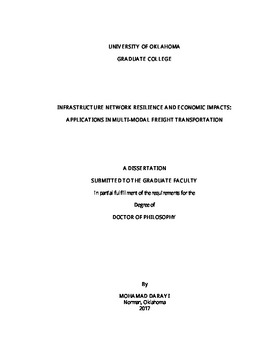| dc.description.abstract | The US has defined a number of critical infrastructures, the disruption of which “would have a debilitating impact on security, national economic security, national public health or safety, or any combination of those matters”. Among these critical infrastructures are transportation networks, which enable the flow of people and commodities, and recent reports suggest that many highways, bridges, and other transit assets in the US fall short of a state of good repair, potentially threatening the efficiency of the network. In 2013, 55 million tons of goods valued at more than $49.3 billion traversed the US freight transportation system each day, and freight tonnage and monetary value rose by 6.3 and 8.0 percent, respectively, over 2007 levels. Over the next 30 years, transportation’s contribution to the US gross domestic product is expected to grow to approximately $1.6 trillion. Given the potential for disruption by malevolent attacks, natural disasters, human-made accidents, or common failures, recent US planning documents focus on the criticality of transportation network preparedness. Emphasis has been placed on “securing and managing flows of people and goods” along transportation networks. The consequences of disruptions to critical infrastructures highlight the need to better understand resilience, or the ability to withstand the effects of and recover timely from a disruption. Particularly for critical infrastructures, the Infrastructure Security Partnership (2011) noted that a resilient infrastructure sector would “prepare for, prevent, protect against, respond or mitigate any anticipated or unexpected significant threat or event” and “rapidly recover and reconstitute critical assets, operations, and services with minimum damage and disruption.” As with any other critical infrastructure, resilience planning is important for multi-modal transportation networks due to their role in the economic vitality of states, regions, and the broader country. The functionality of this network is threatened by disruptive events that can disable the capacity of the network to enable flows of commodities in portions of nodes and links.
This research creates a new paradigm with which to improve decision making for freight transportation network sustainment through an integrated duple of resilience and interdependent economic impact. Integrating a multi-commodity network flow formulation with an economic interdependency model, driven by publicly available data from Bureau of Economic Analysis and U.S. Department of Transportation, I have proposed a framework to quantify the multi-regional, multi-industry impacts of a disruption in the transportation network which has led to (i) defining a new measure of network component importance, (ii) planning for adaptive capacity through contingent rerouting, (iii) investing for absorptive capacity, and (iv) guiding network recovery and resilience. This work has been applied a multimodal freight transportation network in Oklahoma that connects the state to several regional trading states, enabling the flow of six important commodities that have interdependent effects on the Oklahoma economy (classified into 62 industry sectors). | en_US |
